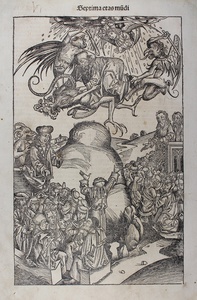| Method | Woodcut |
| Artist | Michael Wolgemut |
| Published | [Anton Koberger, Nuremberg, 1493] |
| Dimensions | Image 375 x 228 mm, Sheet 412 x 282 mm |
| Notes |
A full-sheet woodcut illustration of the events of the Apocalypse, from the celebrated Nuremberg Chronicle. The woodcut, likely engraved by Wolgemut himself, is featured as the closing scene from Hartmann Schedel's discussion of the end of the Seventh Age of Creation, and the coming Apocalypse that will mark the end of the world and the creation of the Kingdom of Heaven. The scene combines a number of separate events into the same image. To the right, the prophets Enoch and Elijah convert the Israelites to Grace, their final act before they are crowned with martyrdom. To the left, a false prophet, with a devil whispering in his ear, coerces the people to worship the antichrist, falsely proclaiming him to be the new messiah. Even the wise men, sitting in a circle in the foreground, are convinced, as the false prophet points to the many portents and wonders of the age. At centre is the Mount of Olives, in the sky above which the final battle of Revelation takes place. The Antichrist, Lucifer, and a group of other demons are slain by the Archangel Michael, who bursts from Heaven in a storm, wielding his sword. Compositionally the scene is very similar to many later illustrations of the Temptation of St Antony, and was clearly an inspiration to Lucas Cranach and Albrecht Durer among others. The Liber Chronicarum, usually referred to in English as the Nuremberg Chronicle or in German as the Schedelsche Weltchronik, is, after the Gutenberg Bible, likely the most famous of all early printed books. A colossal chronicle of biblical history, the text covered the seven ages of the world, from Creation to the contemporary world of fifteenth century Europe, and the coming of the Last Judgement. The text, written in Latin by Hartmann Schedel and translated by Georg Alt for the German edition, was mostly a composite of earlier biblical, scientific, philosophical, and historical works. What set the Chronicle apart from its contemporaries was less the quality of its text than its illustrations, which were carved in their hundreds by the workshop of Michael Wolgemut. The illustrations for some of these blocks may have been executed by the young Albrecht Durer, who was apprenticed to Wolgemut at the time. Estimates suggest that up to 1500 copies in Latin may have been printed, as well as between 700 and 1000 German copies by the publishing house of Anton Koberger. In an attempt to prevent piracy, the blocks were kept under lock and key, and returned to the patrons of the work following printing. Michael Wolgemut (1434-1519) was a German painter, printmaker, and sculptor, whose significant achievements are now largely overshadowed by his much more lauded pupil, Albrecht Durer. His most memorable contribution to the arts is his involvement in the production of the woodcut illustrations for the Nuremberg Chronicle, one of the most important incunabula. Wolgemut's studio, including the young Durer, produced almost two thousand illustrations for this work, and Wolgemut is rightly credited as one of the key figures in securing the primacy of German woodcut printing in the late fifteenth century. Condition: Scratch to centre of sheet. Minor foxing and time toning, mostly to margins. Rust spot to right margin, not affecting image. Latin letterpress title above, and text on verso. Initials on verso manuscribed in red and blue gouache. |
| Framing | mounted |
| Price | £1,800.00 |
| Stock ID | 50699 |

